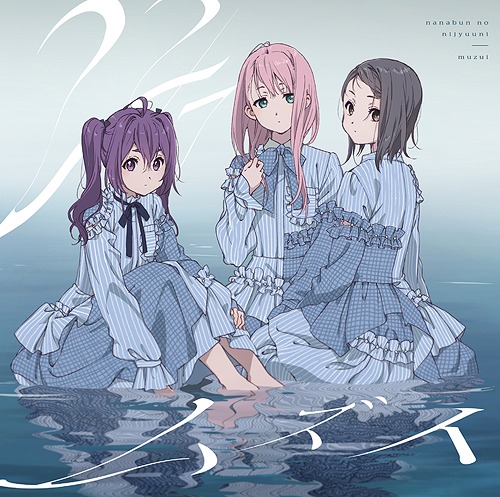
The new decade will surely bring with it many ripples that will tear at the fabric of our very society as we know it. Thankfully, we can be assured of two things in such a tumultuous time: there will be a new anime season every three months, and Taped Reality will show up around two months into the season to offer our unsolicited opinions about which anime of said season are worth your time.
This list is the product of several weeks of voting and debate amongst our pool of authors that have gathered from across the globe. Our tastes aren’t representative of any sort of fandom, but we can guarantee that our final product is the result of input from many unique (in many senses of the word) voices. If you’re looking for some anime recommendations, stay tuned! If you’re here to complain that your favorite show didn’t make the list, it’s time to get some fresh air.
Only shows available for legal streaming are considered. Netflix has complicated what the word “available” means, but we still consider limited-availability shows such as Netflix originals for this list. Winter is upon us! Christmas, New Years, and the whole season to be warm, happy, and enjoying. Now let’s get this ball rolling.
22/7
Genre: Idol, Music, Slice of Life, Drama

Spoiler-Free Synopsis
Miu Takigawa is totally disillusioned with her life. Sad, lonely, and totally lacking in self-confidence, she is working a terrible job to help her family when she gets a strange letter informing her that she has been chosen as part of a new “project”. Partly believing it to be a hoax, she ends up going to the meeting spot where she finds seven other girls who all received the same letter. A major record label has on the spot decided that they are creating an idol group and have chosen these eight girls. Without understanding why this sudden decision has been made, Miu has to make a choice: will she push herself out of her comfort zone and meet the impossible expectations that will be put upon her?
Why You Should Be Watching
The first thing of note is that 22/7 is already an actual idol group performing in Japan today, and the members themselves voice their respective characters, all either first-time or inexperienced at best voice actresses. Some had concerns with the voice acting first, particularly of Miu’s VA, but we find her delivery of Miu’s depression and lack of self-confidence very natural and much more effective than any more “anime” delivery, and to be clear, it’s not through a lack of skill by her VA. 22/7 is also a very strong version of the typical idol anime genre. Miu especially begins to overcome her weaknesses, but eventually, the spotlight moves to each of the girls and portrays their problems and insecurities and how they overcome those. Miu, of course, is the most fleshed out so far, but the other characters have a depth to them as well. The production values are strong, as the art and animation are conventional but detailed. Performances are in CG, but CG has gotten a lot better over the years and this show follows that trend. And, of course, one of if not the most important part of idol anime is the music, and 22/7 isn’t lacking at that either. The whole group sings both the OP and ED, as well, which is always a welcome treat. Overall, 22/7 is a strong example of the idol anime genre that fans both veteran and new will greatly enjoy.
Asteroid in Love
Genre: Slice of Life, Comedy

Spoiler-free Synopsis
A young girl has a fateful encounter with a new friend and makes a promise that will shape her future – that she will someday discover her very own asteroid. Years later, in high school, she joins the Astronomy Club – sorry, the Earth Sciences Club – to achieve this ambitious goal, and finds a few surprises waiting for her…
Why You Should Be Watching
The last few years have seen a major renaissance in shows about Cute Girls Doing Cute Things But Also Teaching You Things, and here we have another strong entry in the genre. Asteroid in Love throws light romantic elements and that trademark Doga Kobo shine into the mix to great success. It’s not the type of show that will ever blow your mind, but it will, at the very least, make you feel comfortable and satisfied, half an hour at a time, and that’s not particularly surprising coming from the writer of Miss Kobayashi’s Dragon Maid and one of the scriptwriters of Non Non Biyori, perhaps the best of its class.
With an adorable cast and a big helping of earnest fun, this is effectively anime junk food, but it’s not the kind that will rot your teeth. If you liked Laid Back Camp, New Game!, or Comic Girls, this will help you fill the void that Room Camp is leaving in your heart this season.
BOFURI: I Don’t Want to Get Hurt, so I’ll Max Out My Defense.
Genre: Slice-of-life, Comedy, Fantasy, VRMMO-Isekai
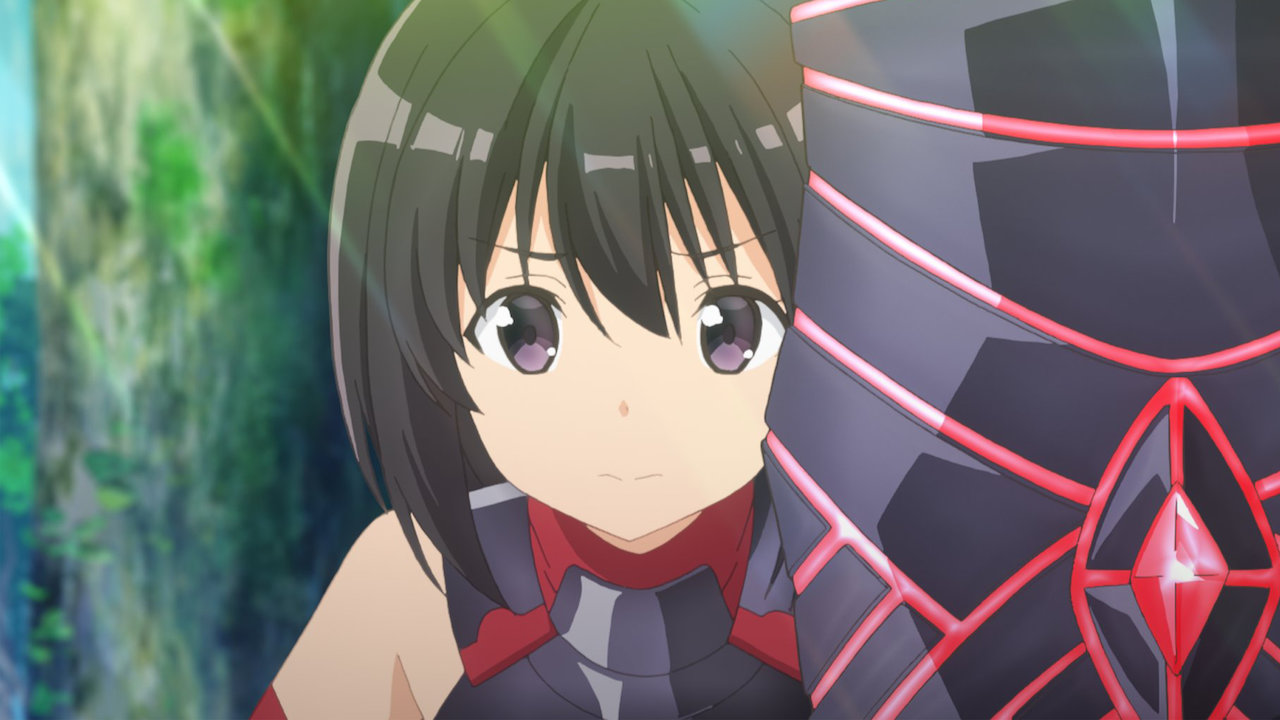
Spoiler-Free Synopsis
Kaede Honjou wants to start playing the new VRMMO game New World Online. There’s just one small problem: she’s never played an MMO before. Add on her aversion to pain, and Kaede ends up allocating all her skill points in defense! Maple, her avatar, becomes an unbeatable tank. Here begins the comfy misadventures of Maple as she explores New World Online, makes new friends, and eats plenty of monsters!
Why You Should Be Watching
Ostensibly, BOFURI idealizes the art of playing an MMO and making friends along the way. Maple experiences little in the way of actual difficulty regarding the game’s mechanics (besides not understanding stat points), but the show readily acknowledges that its MMO setting is a front for a deeper exploration of how we form and foster bonds in virtual worlds. It is familiar and recognizable to anyone who has ever formed a party in an MMO, or a clan in an online shooter.
Maple and Sally, are endlessly endearing in how they act like genuine close friends and in how that closeness defines their online interactions. Sally picks her swashbuckler class to complement Maple’s shield-based class, an obvious but effective metaphor for how the people we surround ourselves with complement who we define ourselves as. Much like Endro~! and Didn’t I Say to Make My Abilities Average in the Next Life?!, BOFURI thrives by understanding that characters lie at the center of what makes a fantasy-based show appealing. Unlike Maple and Sally, we do not watch BOFURI for its groundbreaking fantastical world or unbreakable MMO mechanics; we watch it to see how these well-established and charming characters react to and live in that world.
Regarding BOFURI’s world, perhaps its most appealing aspect besides its characters is its visuals. BOFURI’s vibrant hues perfectly accentuate its central tones. Lush landscapes and inviting urban settings mix with crystalline caves and rich, azure lakes to create a visual buffet. These inviting settings reflect the show’s comfy, serene, and occasionally energetic tone, perfect for watching while wrapped up in a blanket with a warm cup of tea. Or munching on yet another monster, but that might just be Maple’s thing.
Though some may find themselves adverse to the show’s occasional lingering butt shots, BOFURI remains a stellar example of the VRMMO/isekai genre done right. Through its reverence for the eminence and virtue of online friendships and its understanding of its genre, BOFURI stands as one of last year’s best and sets a high bar for a decade of isekai to come.
Darwin’s Game
Genre: Sci-fi Death-AR-Game

Spoiler-free Synopsis
17-year-old high schooler Kaname Sudo unintentionally accepts an invite to a cellphone-based augmented reality game called “Darwin’s Game.” A battle royale, it gives each player a unique ability that ranges from being able to tell when people are lying to water manipulation to even creating weapons out of thin air. While the rewards are tempting (actual cash, motorcycles, etc.), the consequences are hardly what Kaname would call worth it, given that players are tasked with killing one another to score points. After witnessing the death of his friend while playing D-Game, Kaname swears to find whoever created the game and bring an end to the bloodshed. Along the way, he makes alliances with other players, including the very gifted (and deadly) young woman named Shuko, who takes a strange liking to him…
Why You Should Be Watching
Now, we know how it sounds and what you’re probably thinking: “this sounds like trash.” Granted, this does bear some resemblance to Future Diary, and our seasonal round-ups usually forgo recommending enjoyable trash, but therein lies Darwin Game’s unexpected quality: this show is too good to be trash. It’s a legitimately entertaining, engrossing, and overall solid action series that, aside from just one scene at the end of the first episode, has a sense of infectious fun to it. If you’re looking for something that scratches your Adult Swim anime itch, this show is practically made for you.
While not the prettiest show of the season, D-game has undeniably competent production with a keen sense of direction, voice acting with no weak links, and pacing that we dare to say is damn near perfect, never slowing down so much that you lose interest nor going so fast that you lose track of what’s going on. Each episode feels like it covers the right amount of ground in the story and character progression while delivering on some fun fight scenes where we not only see players wage all-out war in city streets but also in how they use their special abilities to manipulate the game to their benefit.
Darwin Game’s only weak spot is the aforementioned scene at the end of the first episode (which we imagined turned some people off, but let us assure you, the show instantly backtracks on it at the beginning of episode 2). Also, we will admit that the characters can be hit and miss, but even this area isn’t what we were expecting. Instead of all the players being assholes like in many other death-games, most of the cast here are actually smart and, at times, empathetic to one another. Very few of the players are in it for the lulz; most are either here by accident or trying to score money they desperately need. This sums up Darwin’s Game in a nutshell: not just trash, probably better than it has any right to be, but nevertheless it’s a properly fun, cool show. Nuff said.
ID: Invaded
Genre: Sci-fi, Mystery, Police, Psychological

Spoiler-free Synopsis
ID: Invaded follows the detective Sakaido as he dives into ID-Wells, nonsensical virtual worlds made out of the unconscious psyches of serial killers. There, he must find clues that Kura, a real-world special police task force, can use to track down the killer and prevent them from hurting any more victims. Former police detective Akihito Narihisago, Sakaido’s real-world counterpart, assists Kura in repentance after his own daughter was brutally murdered by a serial killer. Through his investigations as Sakaido, he must work together with the detectives of Kura (such as rookie detective Hondomachi) to save as many victims as he can as well as uncover the mysteries surrounding perennial victims Kaeru and mysterious mastermind John Walker.
Why You Should Be Watching
ID: Invaded is a mystery show that isn’t really about the mystery itself, at least not in a conventional sense. As Sakaido comes to realize, his goal isn’t to figure out the killer’s identity but instead how the world itself works, how the victim stand-in Kaeru was murdered, and how it relates to the mind of the killer whose mind it is based on. This allows Kura and Hondomachi to track down the killer from the clues that Sakaido discovers. In practice, this means that the audience isn’t entirely meant to deduce the killer’s identity from carefully placed clues throughout the episode but instead to figure out the complexities of whichever world Sakaido is diving into.
Another of ID’s main draws lies in the portrayal of its main character. Sakaido himself is a representation of the archetypical super detective popular in Japanese culture who is able to solve any crime without fail. This is in stark contrast to his real-world version of Narihisago, whose failure as a detective led to the deaths of his family and eventually turned him into a cold, uncaring killer himself. This dichotomy between Narihisago and Sakaido is what makes his character so interesting: Sakaido has no memory of his past defeats or the death of his family and, as such, he has no idea that once he leaves the ID-Well he must return to the life of a broken man who has lost everything. It makes his struggle all the more striking as we realize that despite doing everything right and saving the day inside the wells, at the end of the day he has to go back to the life where he has already lost.
If My Favorite Pop Idol Made It to the Budokan, I Would Die
Genre: Comedy, Slice-of-Life, Idol

Spoiler-Free Synopsis
Eripiyo (her real name is a mystery) is a hardcore stan of Maina, one of the members of the mid-tier idol group Cham Jam. Along with her fellow idol-obsessed friends, Eripiyo does everything in her power to get closer to Maina and propel Cham Jam to a Budokan-status idol group! Maina, meanwhile, comes to find herself taking an interest in Eripiyo. The story of idols, the fans who love them, and the relationships that blossom begins here!
Why You Should Be Watching
Are you sick of idol shows? Do the words “love” and “live” make you convulse uncontrollably? Then If My Favorite Pop Idol Made It to the Budokan, I Would Die might soothe those idol-induced wounds! Where shows like Love Live and The Idolm@aster focus on the trials, tribulations, and successes of idol groups both hopeful and established, Budokan flips the narrative, focusing instead on idol fans and the culture surrounding “stan-dom”
In a cultural climate where allegiance to one’s idols appears to be at an all-time high, Budokan’s focus on this oft-ignored part of people’s lives makes it stand out not only amongst other idol-based shows but among most anime. Eripiyo and her friends act as representations of the obsessive fan inside all of us, the fan who buys every piece of merchandise and plans their life around concerts, meetups, and album drops. Most remarkably, Budokan rarely makes these easy targets the butt of their jokes. Sure, Eripiyo disguising herself as a man to better appeal to Maina is funny in its absurdity, but the show primarily uses moments like these to show the genuine bonds that form in the spaces between celebrities and their fans.
Budokan is a love letter to and exploration of these relationships funneled primarily through the vessels of Eripiyo, Maina, and their budding relationship. As much as our idols affect us, we, too, affect them. In that exploration, the show also explores the pitfalls of stan culture. Eripiyo struggles between wanting Maina and Cham Jam to reach superstardom and enjoying the current intimacy she has with her favorite idol. It is an issue we all face in one way or another, the quandary of reconciling selfish love with the selfless wish for others’ success. Taking this very human theme and applying it to something like idol culture exemplifies Budokan’s tight, culturally relevant writing.
Complementing Budokan’s warm tone and effective script are its gorgeous visuals and character design. The environments are a stunning mix of pastel, watercolor, and intentionally washed-out urban scapes, making the entire production a feast for the eyes. Refreshingly, the characters forgo the overdesigned quality many shows of this ilk fall into, choosing instead to focus on a few key elements per character to make them pop. In particular, are Eripiyo and the idols’ eyes, which effectively use complementary colors and striking detail to grant each character life and act as a window into their personalities.
In/Spectre
Genre: Comedy, Low Fantasy, Mystery, Supernatural, Romance
Spoiler-free Synopsis
To various yokai, Kotoko Iwanaga is a “God of Wisdom”, someone who serves as a mediator between the human society and the spirit society, resolving supernatural problems that come her way. Kotoko approaches Kurou Sakuragawa, a university student who Kotoko has feelings for and someone she thinks has supernatural powers and asks for his assistance in helping out youkai. The story of In/Spectre follows both of them as they try to solve various cases, with one of the more prominent mysteries in the show being the case of “Steel Lady Nanase”.
Why You Should Be Watching
When you think of a mystery show, you typically think of police procedurals and Sherlock Holmes-esque mysteries, right? In/Spectre is a mystery that has a nice low fantasy supernatural spin on the typical mystery genre.
The beauty of In/Spectre is how these two typically opposing genres interweave into each other: because Kotoko is solving for supernatural beings, this leads to an interesting dynamic where her goal is not to find the truth or resolve the problem but to make sure that the yokai are no longer bothered by it. This shift in narrative structure fundamentally changes how we approach the mysteries and the show feels totally different (and fantastic) as a result. Also, as the story of In/Spectre’s story continues, it both effectively drips information about the underlying mystery we’re trying to overcome while also unveiling the fantastical elements of the world in a way that fulfills the desire for world-building.
If you asked us though, the best part of In/Spectre is its characters. Primarily, Kotoko is a wonderful gremlin that never ceases to put a smile on my face due to her wonderful antics and entertaining personality. we’d watch any show with her in it – she’s that delightful. That being said, the dynamics in the show’s relationships are compelling, as well. For example, at the beginning of the show, Kotoko’s relationship with Kuro seems fairly one-dimensional, with Kotoko showing love and adoration but Kuro only showing disdain. As the show progresses, though, it uses gestures instead of words to develop this relationship. They become ever closer and closer until they have a real relationship without directly talking about it. This kind of show-don’t-tell romance is incredibly rare and makes this show something we can’t help but appreciate, with the relationship itself also being absolutely engaging every step of the way.
We can gush about why In/Spectre is a great show for hours if given the time. we’d be waxing poetic about stuff like the engaging dialogue and tight pacing, but, ultimately, it comes down to this: In/Spectre is a low fantasy supernatural mystery that has been consistently capable and constantly enjoyable in ways only a few anime are every season. Not just thanks to an amazing gremlin, but because it’s a complete package – give it a watch.
Keep Your Hands Off Eizouken!
Genre: Comedy

Spoiler-free Synopsis
Midori Asakusa is an exceptionally talented artist with a hyperactive imagination who can visualize something as simple as painting a wall as if she was doing repairs on a spaceship. She constantly dreams of making her own anime but is too shy to truly get her dreams off the ground. That is until a chance encounter with a famous up-and-coming model at her school named Tsubame Mizusaki who dreams of becoming an animator. Together, this duo of artists, along with Midori’s money-loving friend Sayaka Kanamori, form a club called the Eizouken at their school that is ostensibly about making films but is really about making anime.
Why You Should Be Watching
There are multiple layers as to why one should check out Keep Your Hands Off Eizouken!. At the most basic, the show goes to great lengths breaking down the process of making anime, covering aspects such as how the actual animation is created to often overlooked components such as the sound effects. In a way, this makes the show somewhat similar to the also excellent Shirobako; unlike Shirobako, however, Eizouken doesn’t entirely sugarcoat things regarding the sheer difficulty of making anime, with a recurring conflict in the series being the crunch of their project deadline butting heads with the personal goals Midori and Tsubame have for the given animated work, leading to a lot of compromises and cut corners when necessary.
While it would be rather easy to simply summarize Eizouken as a show about “making anime”, a lot of the content, and in particular the character motivations, really speak to the creative process as a whole. It perfectly captures the perpetual cycle creatives go through of inspiration, creation, and release. Midori specifically is an incredible audience insert for some people, because her worldview is extremely relatable to many people.
Stemming from how Midori views the environment around her, quite possibly the crown jewel aspect of this show has to be its imagination sequences. Whether it is Midori or Tsubame thinking up something on the spot, one of their brainstorming sessions where the show takes on a gorgeous key-frame-inspired look, or how audiences in-universe view their finished works. Time and again these scenes grab the viewer’s attention in a vice-like stranglehold. You don’t even need to be an animator or artist to walk away from every episode thinking, “This show ‘gets’ it!”. Nor do you need to be a professional creative, either. As long as you have that burning flame of passion to create, you’ll find a kindred spirit in Keep Your Hands Off Eizouken!.
Magia Record: Puella Magi Madoka Magica Side Story
Genre: Dark Magical Girl, Fantasy

Spoiler-free Synopsis
Return to the world of Puella Magi Madoka Magica, where magical girls gain incredible power through wishes, though at terrible personal cost. A rumor claims that in Kamihama city, magical girls can be saved. Iroha Tamaki travels to Kamihama to find the truth behind her sister’s mysterious disappearance and becomes embroiled in a plot to defy the inescapable fate that befalls all magical girls who succumb to despair.
Why You Should Be Watching
2011’s Madoka Magica was a perfect 12-episode series that did not require a sequel. It received one in the form of the movie Rebellion in 2013, and fandom is still split on whether this was a masterpiece or an abomination. Magia Record is not a sequel in the strictest sense of the word, but it does assume significant viewer knowledge in that it does very little to explain the state of its world or the place of magical girls within it. Based on a mobile RPG with gacha mechanics, there is as a result a much larger cast – though, with excellent character designs, it is not hard to tell most characters apart.
Although the story seems to be set during one of Madoka Magica’s earlier timelines, the story is focused around the new main character Iroha and her quest for the truth, aided by a core group of friends. As of episode 7, the fifth member of her team has not yet even been introduced. A couple of the original show’s quintet have popped in for cameos, with more likely to follow. The original series was impressively economical with its storytelling. Magia Record is less so – however, it manages to condense a bloated and at times messy game story into a coherent adaptation that improves on the source material.
With returning artistic powerhouse Gekidan Inu Curry on visual duties, every episode contains at least one gorgeous and surreal fight scene set in a bizarre world of animated collages that maintains that very singular Madoka Magica aesthetic. Shaft continues to shine in terms of production – this is a visually arresting show that is never boring to watch, with bright colors and interesting design that elevate a relatively pedestrian story.
Iroha herself is a cipher, but her supporting players are colorful and fun – we’re particularly fond of self-titled “Mightiest Magical Girl” Tsuruno Yui whose perpetually chirpy demeanor overlies deep emotional pain. Even initially annoying brat Felicia Mitsuki has a sympathetic backstory that is more complex than it first appears.
So far, no one has had their head bitten off or been transformed into a murderous despair monster, so this story at once seems to have lower stakes than the epic original. However, it seems highly unlikely they will manage to adapt the entire story into a single 13-episode season, so we would bet on there being a second to conclude it. Perhaps it will ramp up in intensity later. It seems strange that a relatively throwaway production like this would outpace the original in terms of episode count, and so far have much less to say.
Come for the gorgeously animated fight scenes, bonkers production design, and sympathetic characters, but whether you will wish to stick around for the lighter story remains to be seen.
Smile Down the Runway
Genre: Slice of Life, Drama, School, Shounen
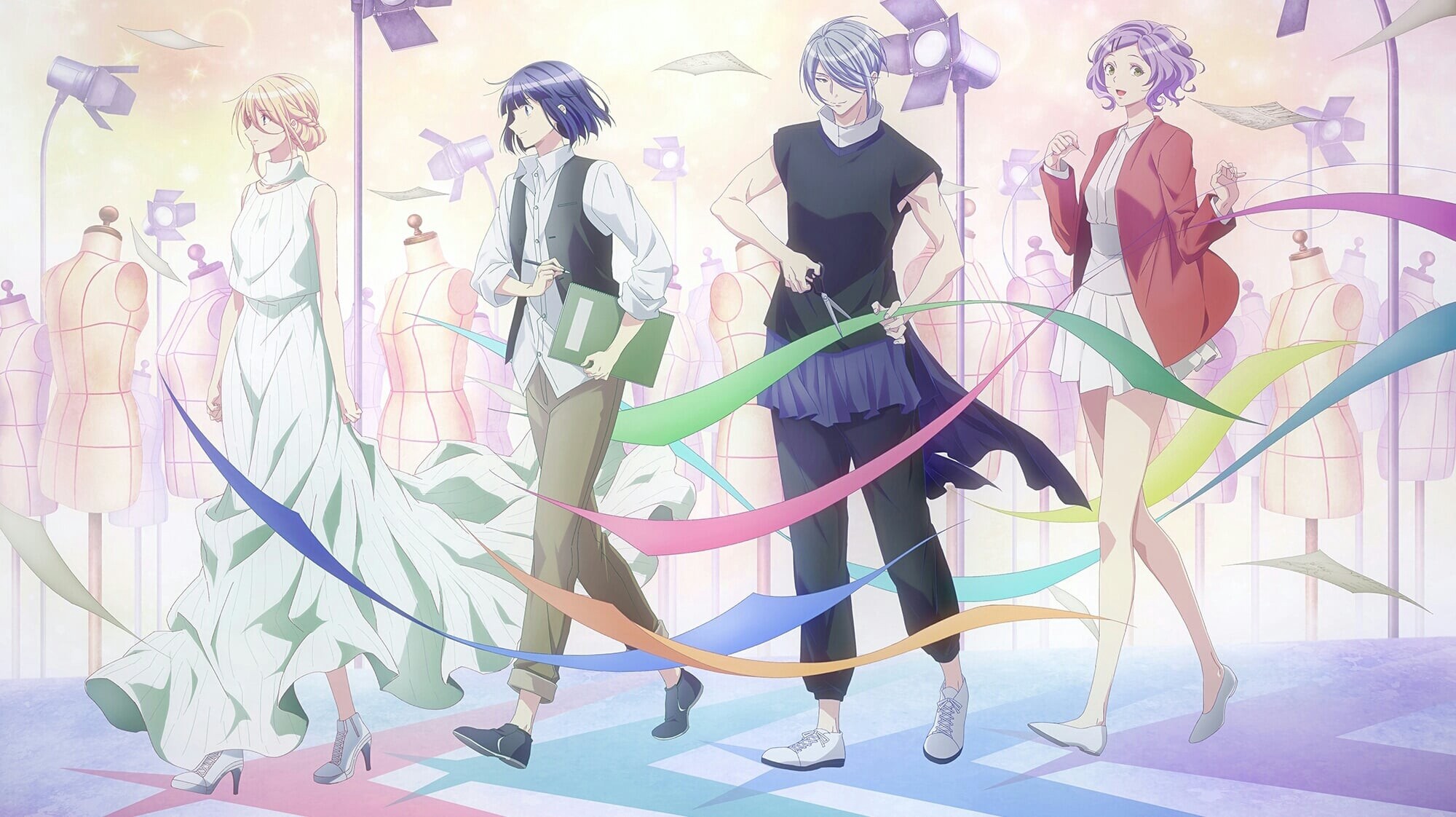
Spoiler-free Synopsis
Smile on the Runway’s story revolves around two ambitious teenagers. One is the daughter of a famous supermodel company’s CEO who has always dreamt of being a model. The other is the only member of the sewing club, an aspiring clothing designer whose only clients are his family members. They each face upfront challenges that may hinder their dreams, but if they work together they may realize their future in fashion.
Why You Should Be Watching
Anime as a medium has the unique ability to feature any sport or activity and tell a story appealing to those who wouldn’t normally be fans of the subject matter. For example, if you’ve never participated in, watched, or even paid any attention to volleyball, you will likely enjoy Haikyuu! if you enjoy shounen anime. The same can be said for Runway. Being a fan of fashion or runway models is not a prerequisite to appreciating what it has to offer.
The anime reels you in with its masterful visuals which highlight the efforts of the characters and keep you onboard through thoughtful storytelling and likable characters. Runway is a unique and fresh take on the genre; it is something that fans of typical Sports-Shounen should try out.
Somali and the Forest Spirit
Genre: Fantasy, Adventure, Drama, Slice of Life

Spoiler-free Synopsis
When a nameless golem protecting a forest discovers a young human girl left alone, it vows to safely take her across a fantasy world to find other humans. Despite her innocence, this girl is at great risk as humans are on the chopping block for many different creatures. For reasons that are revealed early on, the golem is in a race against the clock to ensure the cheerful Somali is given safe passage.
Why You Should Be Watching
It is a rare occurrence where we receive an anime focusing on what it means to impact a future generation. Perhaps even more unheard of is when we get to see such focus amidst a fantasy series. Somali and the Forest Spirit is an emotional journey that follows a golem and a young human girl across a harrowing fantasy world. Somali might be the most impactful show of the season because of its blending of storytelling with amazing background art and music.
On the surface, this show has its titular character doing cute things as a stoic golem watches her. What it is beneath, however, is a gripping reflection on what our actions mean for the future generation. Some of this is founded on misunderstandings between guardian and child, while others are far grimmer with tales of guilt and vindication. It takes dark, chilling turns while, ultimately, keeping the childlike innocence of young Somali intact. The show reveals some of its hands fairly early (we know what the finale of this story will be); however, it never detracts from the journey at hand. If anything, it elevates the show by allowing audiences a window into what an otherwise stonewalled being is thinking.
Somali won’t be for everyone- it goes at a slower tempo and has a few dark turns that might turn away both those who don’t like easier shows and those who don’t like graphic imagery. It tells you where the story is going, which is not always a welcomed narrative tool. These small points should not deter audiences from giving this a go. At worst, we believe that people will find Somali and the Forest Spirit to be a solid series and at best be moved by the emotion conveyed in the storytelling and breathtaking background art.
Sorcerous Stabber Orphen
Genre: Fantasy, Action, 90s Nostalgia
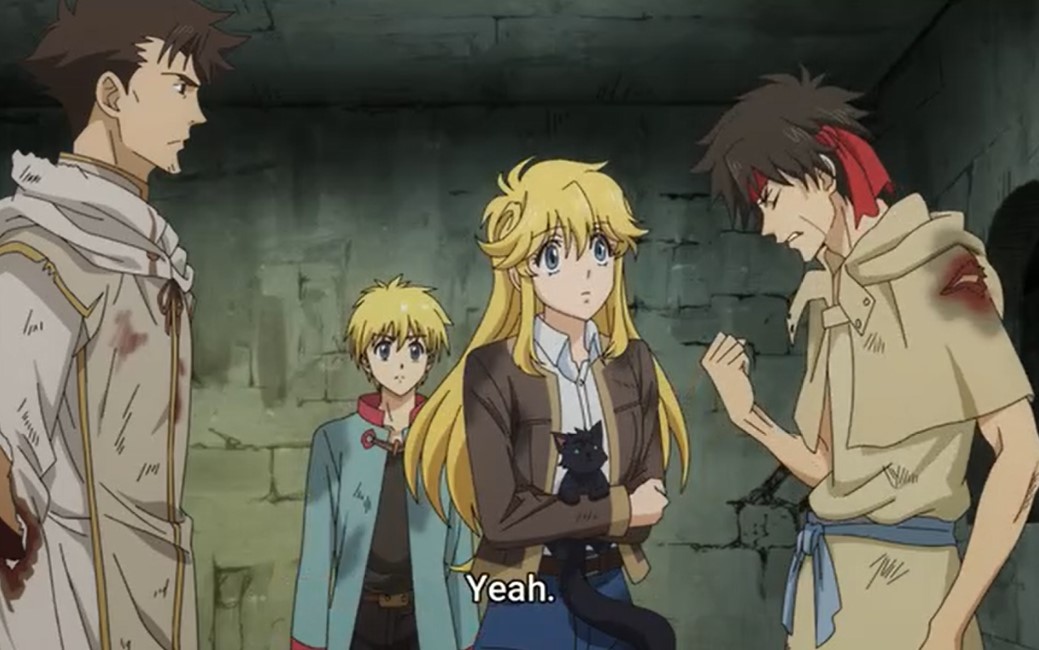
Image Source: Google Images
Synopsis
Orphen (birth name: Krylancelo… we’d have changed it too) was once the most promising student at the school of sorcery known as the Tower of Fang but left under shady circumstances and now works in unsavory businesses like moneylending. That is until he is drawn against his will into an attempted marriage scam and encounters Bloody August, a terrifying dragon with whom he has a deep history. Now he travels with an heiress who won’t leave him alone, a long-suffering apprentice, and two mostly useless dwarves as he attempts to (for various spoiler reasons) protect Bloody August from other sorcerers sent by the Tower.
Why You Should Be Watching
Sorcerous Stabber Orphen was one of the last great franchises of the 90s, dropping in 1999. It never reached the heights of a Cowboy Bebop or Outlaw Star, but it maintained a somewhat cult following. This remake by Studio Deen (DEEEEEEEN!) resurrects this vestige of a forgotten age for a new century and new audience. And it’s pretty good!
The best decision Deen made was to hack out a great deal of the filler material from the original show, dramatically improving the pacing. The story of Orphen and his pursuit of the dragon, which in the original series took up all of season 1, is dispatched here in 3 freakin episodes. This leads to a much tighter-plotted show, even if it does sacrifice some character building.
The things that made Orphen popular in the 90s are still here: the well-realized fantasy world, which feels familiar without being derivative; the magic, whose rules are loosely defined enough to make sense while still being interesting; and, of course, the characters. They suffer a bit from being products of their era; the female characters often get short shrift, and everyone’s written a bit broader than if they were created today. But they’re still a loveable group of mismatched travelers whose adventures you want to follow. Orphen himself is, naturally, the standout, being an MC that’s heroic and still flawed without being overly hot-headed, obliviously dense, or a collector of harems.
If you’re looking for a fun fantasy adventure you’ll find a lot to enjoy with Orphen. But if you have nostalgia for the original show or just anime of that era in general, you’ll probably love this. Give it a stab.
Toilet-Bound Hanako-kun
Genre: Supernatural, Mystery, Shonen, Comedy
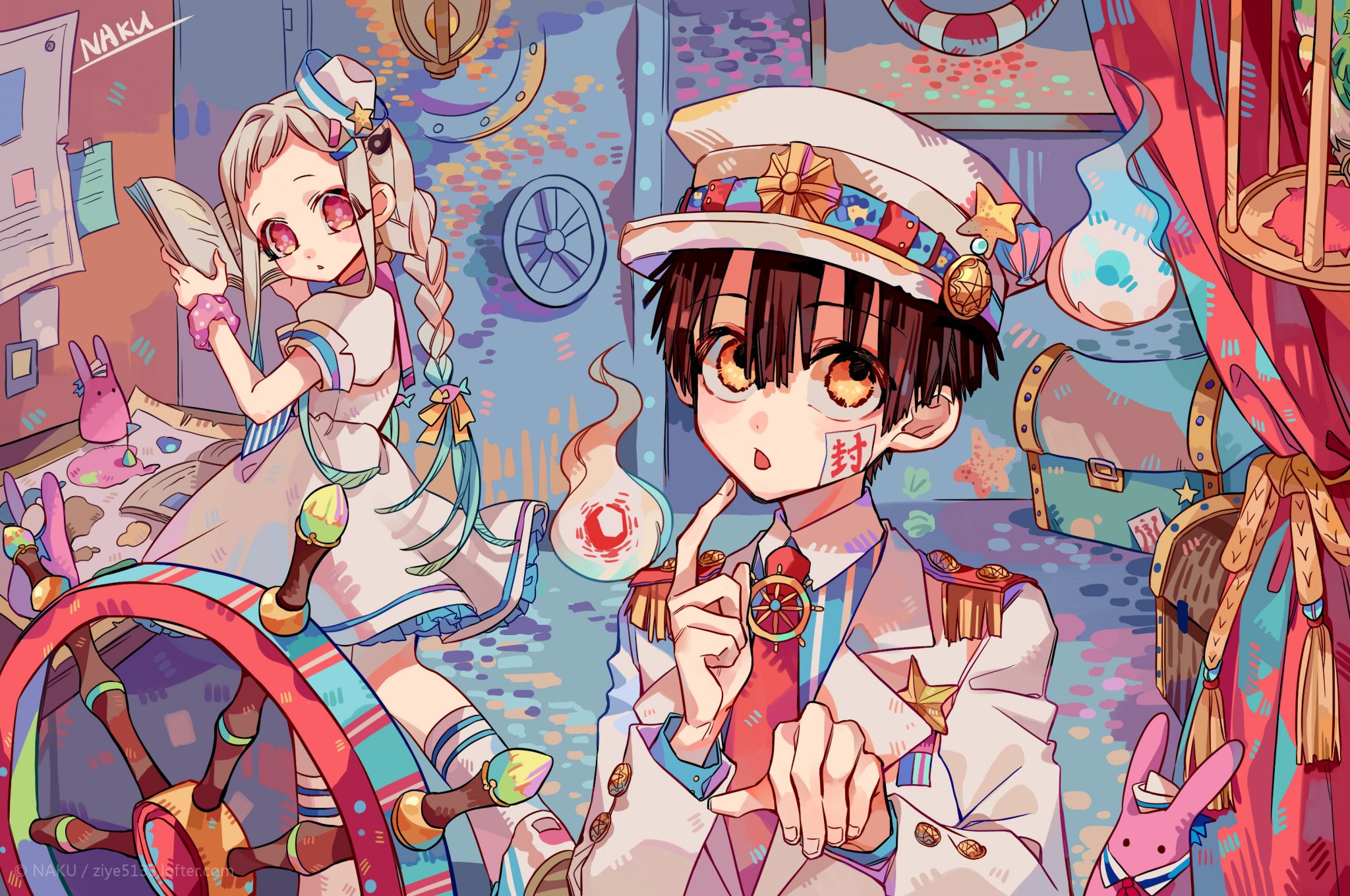
Spoiler-free Synopsis
“Hey! Did you hear the rumor? It’s about the third stall of the third-floor girls’ bathroom in the old school building. They say if you knock three times and ask the spirit of the girl who died there for a wish, she’ll grant it…”
Kamome Academy is home to many mysteries and unaccounted stories. Among the famous Seven Mysteries of the school, there exists one that is rumored to grant wishes… at a price. Longing for a boyfriend and true love, high school first-year Nene Yashiro seeks out the seventh wonder known as “Hanako-san of the Toilet.” But when she knocks on the toilet stall and discovers the rumor is true, she gets more than she bargained for when the ghost who appears is a boy.
This is the story of a girl and the guardian specter who watches over the students and the spirits that inhabit the school.
Why You Should Be Watching
Over the years, Lerche has built quite the reputation, having worked on several remarkable titles (Assassination Classroom, Kino’s Journey) and quickly becoming one of our favorite animation studios in recent memory. Following up from last year with two of our personal AOTY nominees, Lerche’s latest work is an adaptation of Iro Aida’s manga. A supernatural tale based on folklore and other infamous ghost stories, Toilet-Bound Hanako-kun tells the story of a high school girl who seeks out the titular apparition, only to become his assistant following a life-changing event.
Beyond its gorgeous artwork and visuals, Hanako-kun sets itself apart from the traditional “Seven School Mysteries” stories and tropes by inverting them, giving them an extended background, or playing them up for laughs. Starting with Hanako, who is revealed to be a boy instead of a girl in this iteration, he quickly establishes himself as a whimsical teaser who enjoys watching humans as he monitors the world around him and the other “supernaturals” who call the academy home. But behind his mischievous demeanor lies a complex character who longs for company and has at least one literal skeleton in the closet, though his true motives remain a mystery. Despite being a mystical wish granter, Hanako is quick to determine Nene’s wish for “true love” was superficial at best as he attempts to opt for more practical solutions before she hastily consumes a love charm without learning how it worked.
Lead heroine Nene plays the love-stricken but normal human spectator, alternating from playing the “straight man” to Hanako’s playful nature or the source of hilarity as her bold personality and rose-colored optimism prevents her from seeing the heart of the matter initially. Upon eating a mermaid scale without learning the full conditions of how it worked, she decides not to use the second scale on her crush to complete the curse after giving Hanako’s words some thought, transforming her into a goldfish and attracting another apparition. Granting her a second wish, Hanako takes half the curse on himself to change her back “in exchange for her body” (much to Nene’s bewilderment) before revealing what he meant as an assistant.
Between the back and forth chemistry between its leads, the world-building and true nature of the school’s supernaturals, and a delicate balance of fantasy and humor, Toilet-Bound Hanako-Kun is shaping up to be another solid anime adaptation among studio Lerche’s ever-growing portfolio.
Netflix Graveyard: Dorohedoro
As noted earlier, only shows available for legal streaming are considered. However, Netflix has complicated what the word “available” means. This category is for recommendations of shows with region-locked Netflix availability. We expect that they will be released worldwide in the near future, so keep these on your radar if they are not available in your region.
Genre: Drama-Action-Comedy…Dractiomedy
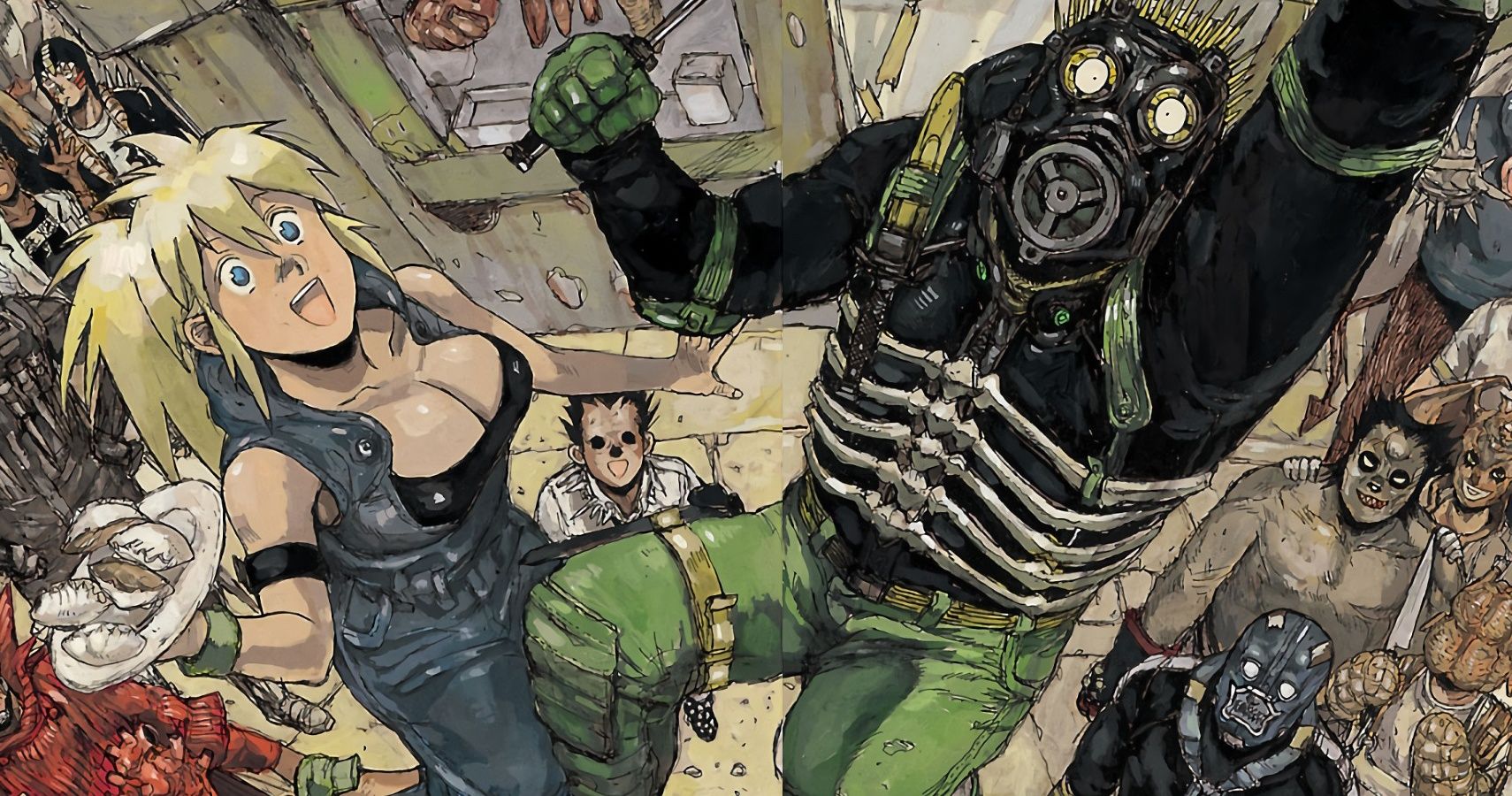
Spoiler-free Synopsis
Experience an old-school cyberpunk world where all problems can be solved with violence. Caiman is searching for an evil sorcerer and boy does he love gyoza! Did we mention he has a lizard head? You’ll learn about the world of “Hole” and the strange magic of the sorcerers. Since it’s based on an older property, you won’t see many of the tropes that you’d expect from modern anime.
Why You Should Be Watching
Dorohedoro oozes personality with a cast of characters we didn’t expect to like. If you miss the weirder, hyper-violent stuff that marked anime in the early ’90s, you’re in for a treat.
The story is told from the perspective of the protagonists (Caiman and Nikaido) as well as some lovable antagonists. We enjoy a story that gives equal time to both sides because you don’t always know who to root for. At first, we found ourselves going back and forth over who is “truly evil,” but luckily the characters aren’t quite so black and white. The world, however, is almost entirely rotten. We hesitate to call Dorohedoro “cyberpunk,” but its world carries the same significance as one. That is to say, it endears you to the actions of its characters. Casual murder and inherently evil magic wouldn’t work without a world in which those were daily activities. So every time Caiman sticks a dude’s head in his giant lizard mouth, you understand that it’s just how things work around here!
One of the ways Dorohedoro overwhelms the viewer with “grit” is with its use of texture on top of some of the best CGI we’ve seen in anime. Mappa takes advantage of 3D models and environmental lighting to maintain a staggering level of detail that would be quite expensive otherwise. Little bits like Caiman’s pillow sticking to his head spikes when he wakes up or the excessively detailed mushrooms that a certain sorcerer is enamored with all add personality and levity to the violent themes that the show can’t help but beat you over the head with. It might sound like we’re describing a “Borderlands” anime, but Dorohedoro actually boasts decent characters and writing that overshadow its attempts at being overly edgy.
We typically roll our eyes at shows that seem to try too hard, but we can’t help but love Dorohedoro. Flawed characters in a flawed world can be very endearing if you’re willing to give them a shot.
Honorable Mention: Science Fell in Love, So I Tried to Prove It
(Note: Our honorable mention section is reserved for shows that had significant support but at the same time significant pushback during our debates. In order to represent both sides, we include both “for” and “against” opinions for our honorable mentions.)
Genres: Comedy, Slice of Life, SCIENCE!

Spoiler-free Synopsis
Shinya Yukimura and Ayame Himuro are young but extremely brilliant researchers at Ikeda Lab at Saitama University, and both of them strongly believe in math as the most powerful instrument at Mankind’s disposal to understand all things.
So when Ayame suddenly confesses her feelings to Shinya, they decide to start an ambitious experiment with his whole team to answer a question: is it possible to explain something complicated like love using a mathematical, scientific approach? Can you prove the base conditions for “love”? Let’s find out! FOR SCIENCE!
Why You SHOULD Be Watching
Here’s the thing, fair readers of Taped Reality: all opinions on anime are subjective, but nothing is more subjective than humor. This makes it difficult to define whether a comedy is “good” or not, especially when it’s a pure comedy where the jokes are the whole point and not a hybrid like action-comedy or comedy-drama. For a series like Science Fell In Love So I Tried to Prove It (hereafter referred to by its shortened Japanese name, RikeKoi), it only works as a show if it’s funny. Thankfully, at least in the opinion of this humble writer and some members of your Collaboration team, RikeKoi is very, very funny.
Some have leveled the accusation that this is a one-joke show, but this is an unfair and gross oversimplification. Yes, the comedy flows from the premise of science-types wildly overanalyzing romance to hilarious degrees, but it utilizes that premise as its foundation and comes at it from a variety of angles. It’s not just the two main characters taking scientific research to a place it probably shouldn’t go; it’s the reactions to them from the rest of the cast, all of whom are amusing in their own ways. It’s a group of ridiculous individuals who play off each other in highly amusing ways, through the lens of being brilliant at science and baffled by things like “romance” or “atmosphere” or “normal”. Plus there’s the science bear, a mascot who pops out at various times to begrudgingly explain some high-level science or math terminology. Look, if a grumpy bear trying to explain quantum physics isn’t funny to you then God be with your poor, cold, blackened soul.
This is a show where a female character whips out a laptop out of nowhere to give an annoying suitor a PowerPoint presentation on why he is undesirable. If that sounds at all amusing to you, we urge you to watch the first 3 episodes, which dropped together initially and culminated in a “romantic date experiment” that was intensely entertaining. Give RikeKoi a shot and see if it tickles your funny bone.
Why You SHOULD NOT Be Watching
Science Fell in Love, So I Tried to Prove It is a series that struggles to understand how to make the most of its comedic stylings. The only aspect that intrinsically works is the heightened, super self-serious nature of the characters, but that quickly wears thin because the tone and delivery have little variation. This blandness arises from the lack of attention given to crafting jokes with actual set-ups or comedic escalation, rather than relying on characters launching into a stream of loosely connected, regularly misapplied scientific concepts and arbitrary terms. Not that one expects scientific accuracy from this anime, but when referential humor is the foundation of all the jokes, one would hope that the scientific ideas could lead to smarter funny moments instead of just an aimless flurry. When the series does commit to building a single scenario, it either outstayed its welcome by reusing the same joke over and over (literally just changing the angle of the shot in some cases) or cuts the comedic tension too early with pointless cutaways to chibi reaction shots that reset the growing amusement. It has a poor rhythm and flow, making each episode a long twenty-four minutes.
The existence of characters has been mentioned – what their personalities are remains Science’s greatest mystery. The cast rarely just talk to each other in any way that gives an indication of dispositions, feeding into a flat dynamic and the absence of strong comedic conflicts. Two smart people, who overanalyze their mutual attraction in ridiculous ways? This should be funnier than it is, and for a romantic comedy, the audience should probably have something to latch onto that invests them in the characters. But they can’t, because there are no real characters—vague archetypes, maybe. In the rare moments that it is genuine, extended conversation and one scientific experiment is taken to its illogical extreme, the jokes land, and Science is suddenly a much better anime series. Those occasions are too rare to sit through the rest of it, unfortunately.


